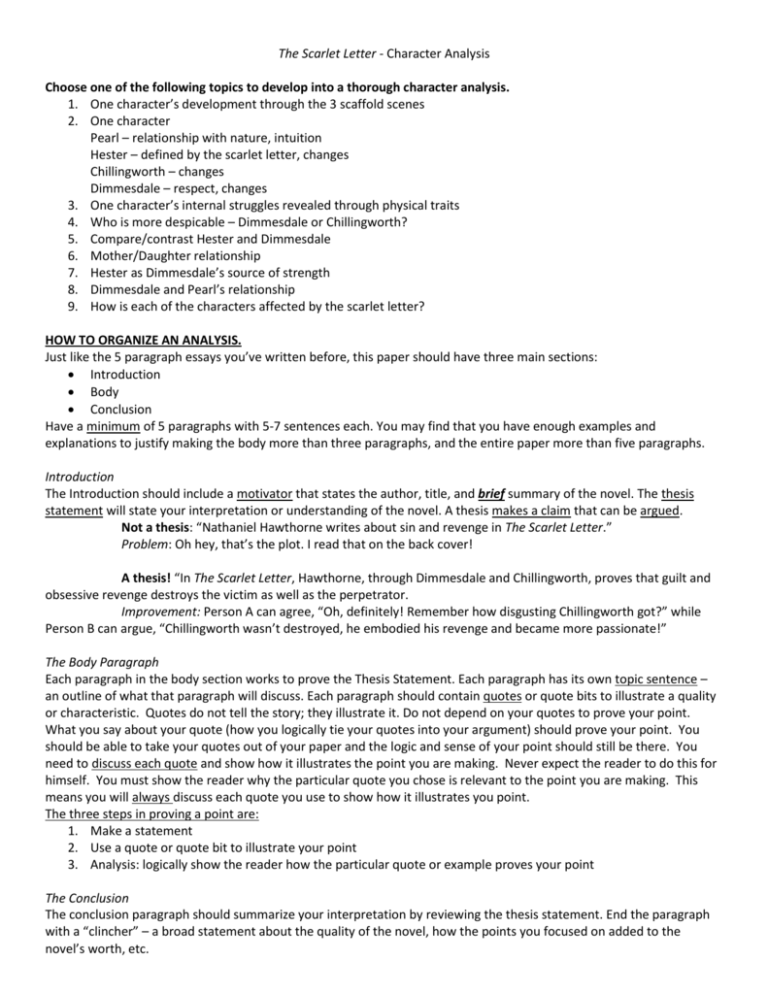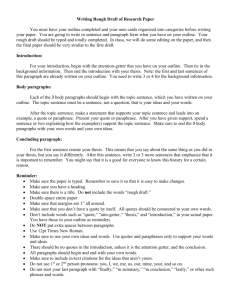The Scarlet Letter - Character Analysis Choose one of the following
advertisement

The Scarlet Letter - Character Analysis Choose one of the following topics to develop into a thorough character analysis. 1. One character’s development through the 3 scaffold scenes 2. One character Pearl – relationship with nature, intuition Hester – defined by the scarlet letter, changes Chillingworth – changes Dimmesdale – respect, changes 3. One character’s internal struggles revealed through physical traits 4. Who is more despicable – Dimmesdale or Chillingworth? 5. Compare/contrast Hester and Dimmesdale 6. Mother/Daughter relationship 7. Hester as Dimmesdale’s source of strength 8. Dimmesdale and Pearl’s relationship 9. How is each of the characters affected by the scarlet letter? HOW TO ORGANIZE AN ANALYSIS. Just like the 5 paragraph essays you’ve written before, this paper should have three main sections: Introduction Body Conclusion Have a minimum of 5 paragraphs with 5-7 sentences each. You may find that you have enough examples and explanations to justify making the body more than three paragraphs, and the entire paper more than five paragraphs. Introduction The Introduction should include a motivator that states the author, title, and brief summary of the novel. The thesis statement will state your interpretation or understanding of the novel. A thesis makes a claim that can be argued. Not a thesis: “Nathaniel Hawthorne writes about sin and revenge in The Scarlet Letter.” Problem: Oh hey, that’s the plot. I read that on the back cover! A thesis! “In The Scarlet Letter, Hawthorne, through Dimmesdale and Chillingworth, proves that guilt and obsessive revenge destroys the victim as well as the perpetrator. Improvement: Person A can agree, “Oh, definitely! Remember how disgusting Chillingworth got?” while Person B can argue, “Chillingworth wasn’t destroyed, he embodied his revenge and became more passionate!” The Body Paragraph Each paragraph in the body section works to prove the Thesis Statement. Each paragraph has its own topic sentence – an outline of what that paragraph will discuss. Each paragraph should contain quotes or quote bits to illustrate a quality or characteristic. Quotes do not tell the story; they illustrate it. Do not depend on your quotes to prove your point. What you say about your quote (how you logically tie your quotes into your argument) should prove your point. You should be able to take your quotes out of your paper and the logic and sense of your point should still be there. You need to discuss each quote and show how it illustrates the point you are making. Never expect the reader to do this for himself. You must show the reader why the particular quote you chose is relevant to the point you are making. This means you will always discuss each quote you use to show how it illustrates you point. The three steps in proving a point are: 1. Make a statement 2. Use a quote or quote bit to illustrate your point 3. Analysis: logically show the reader how the particular quote or example proves your point The Conclusion The conclusion paragraph should summarize your interpretation by reviewing the thesis statement. End the paragraph with a “clincher” – a broad statement about the quality of the novel, how the points you focused on added to the novel’s worth, etc. Character Analysis Rubric – 100 points Name__________________________________________Date______________ Requirements Introduction Thesis Statement Body paragraphs Content Quotes & Evidence Conclusion MUGS Exceeds Expectations Meets Expectations Below Expectations Needs Improvement 5 paragraphs, 5-7 sentences each, typed, double spaced, creative title, TNR 12 point font, one inch margins, page #s Gives author, title, and a brief summary of the work. Includes interesting hook/ motivator. Complete, detailed, takes a stance, and can be argued. Includes a “blueprint” for the essay. Almost all of the requirements are met. Most of the requirements are met. Many requirements were not met. At least 3. Include topic sentences, transitions, excellent support and rationale. Logically supports and proves thesis statement. Clear transitions are used and written in logical order. Includes quotations, reasons, and other evidence. Uses a variety of sentence structures. Exceptional incorporation of quotes and other evidence. Each quote inserted correctly into paragraph and explained clearly. Correct parenthetical documentation. Reviews thesis statement. Sums up main points of essay, 5 sentences, and includes clincher. MUGS are nearly perfect. Verb tense is consistent. Score /10 Summary of work too general or too detailed; adequate hook/ motivator. Inadequate or missing hook/ motivator. Adequate summary of work. Missing author, title, summary of work, and hook/motivator. Takes an adequate stance, can be somewhat argued. Includes a basic “blueprint” for essay. Does not take a stance or does not include a blueprint for the essay. At least 3. Includes topic sentences and some transitions. Includes adequate quotations, reasons, and other evidence. Clear transitions are used but one or more ideas seem out of place. Uses occasional variety of sentence structures. At least 3. Includes topic sentences and some transitions. Some ideas seem out of place, unrelated, or unsupported. Includes some quotes and evidence OR quotes and evidence lack explanation. Some transitions used, paper lacks order. Repetitive or basic sentence structure. Few quotes incorporated; paragraphs lack evidence. Quotes stand alone and lack evidence. Some correct parenthetical documentation. Does not take a stance, does not include a blueprint for the essay, basic summary of book/idea. Missing topic sentences and/or transitions. Many ideas seem out of place, unrelated, or unsupported. Lacks quotes and evidence. Paper hard to follow. Repetitive or basic sentence structure. Incorporates quotes and other evidence. Each quote relates to paragraph and has some explanation. Correct parenthetical documentation. Refers to thesis statement. Slightly repetitive and includes adequate clincher. MUGS are generally correct. Verb tense is usually consistent. Restates (copy/paste) thesis statement. Less than 5 sentences or missing adequate clincher. Frequent MUGS errors. Verb tense is inconsistent. /15 /10 /20 Paragraphs lack quotes and evidence or quotes inserted without reason or explanation, not incorporated into sentence. Incorrect parenthetical documentation. Lacks review of thesis statement. Less than 5 sentences, missing clincher, and vague summary of ideas. MUGS make writing hard to understand. Total __________/100 /20 /15 /10




